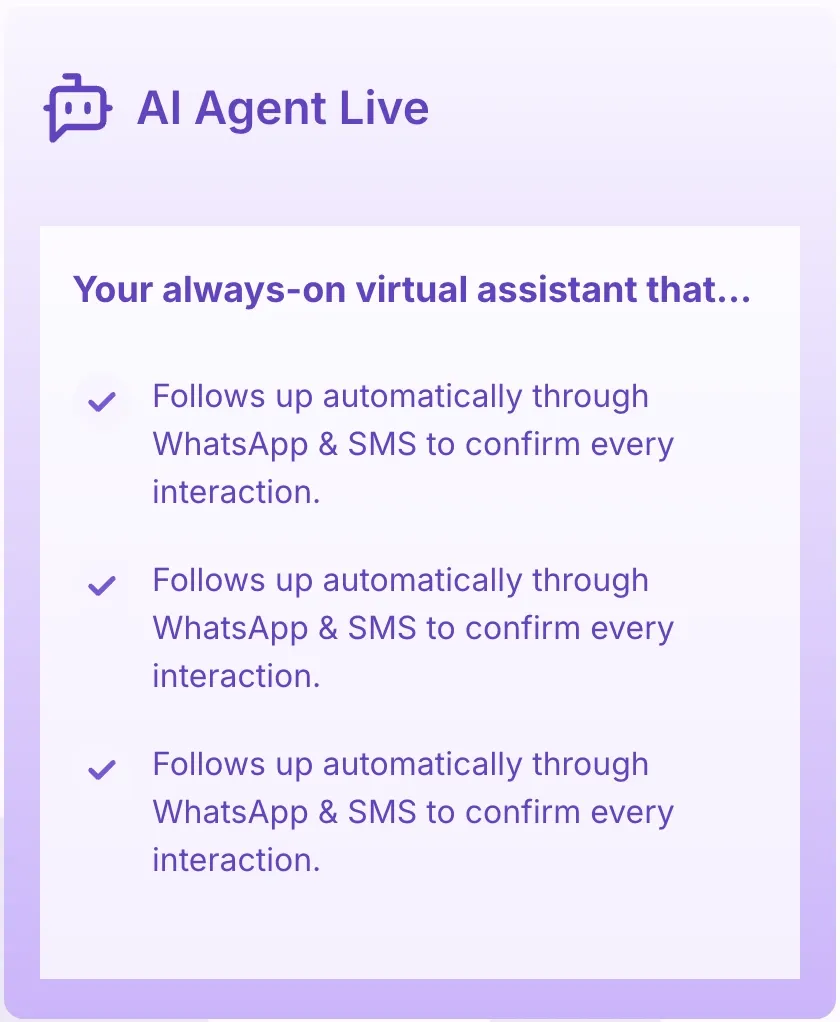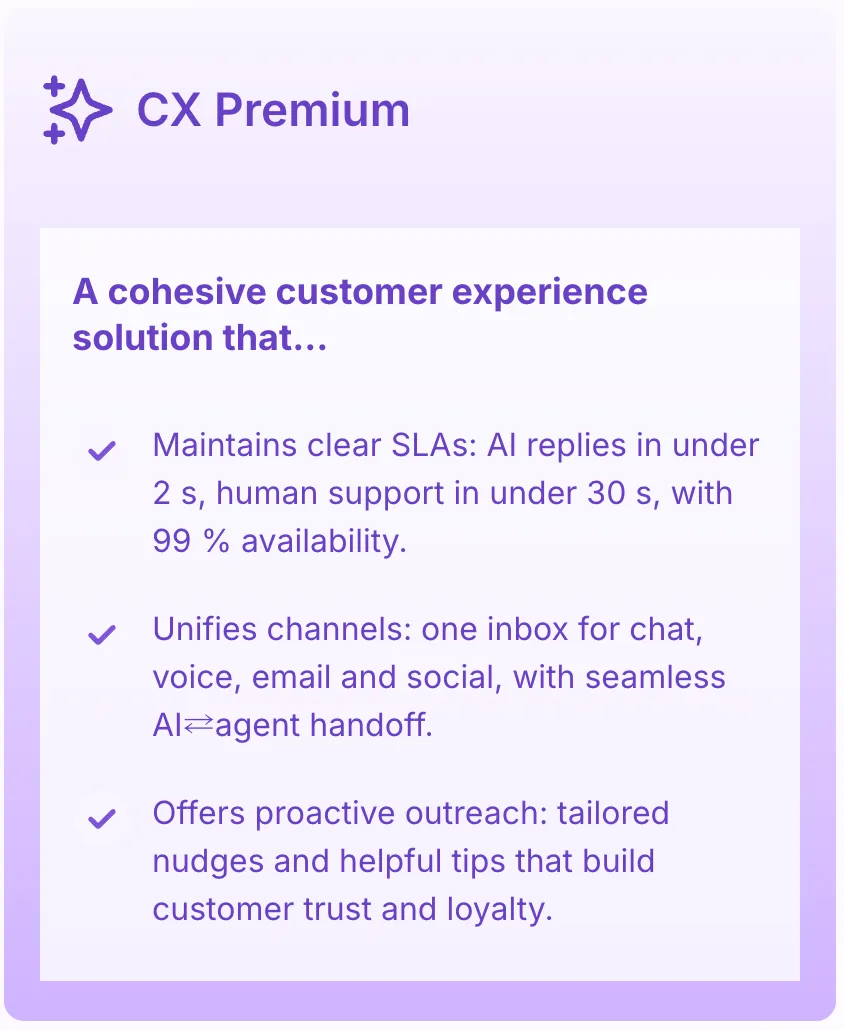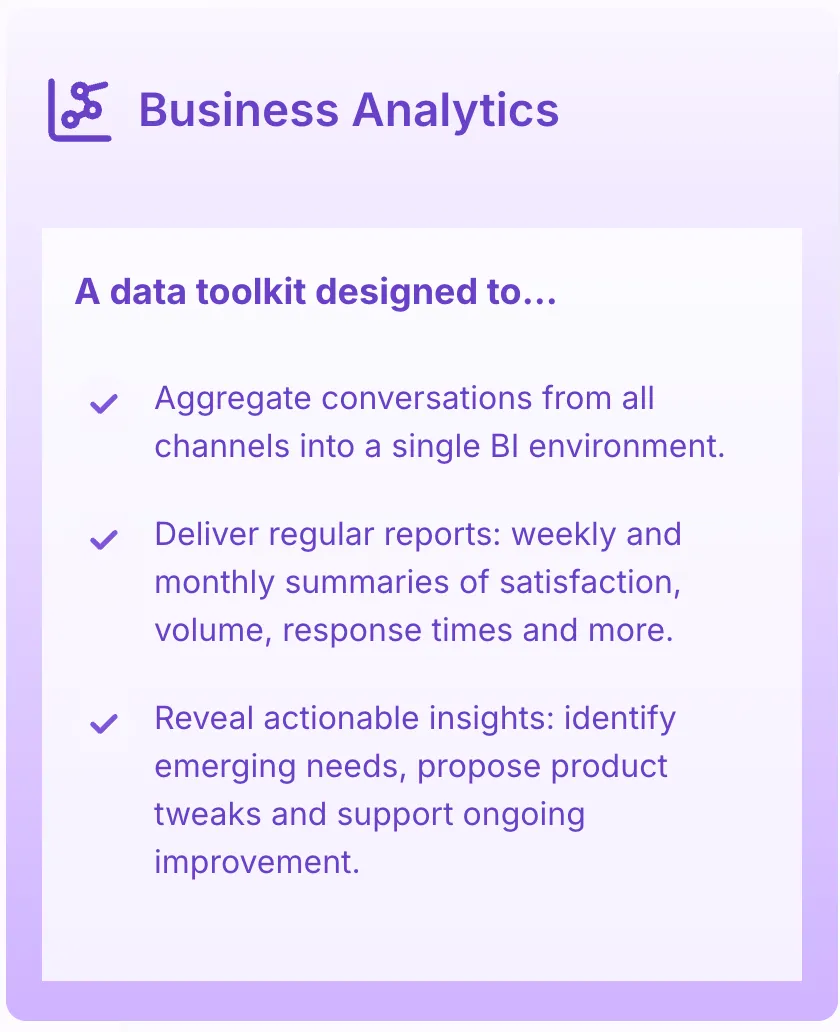Think of CSAT as your customers' report card for your business. When a customer interacts with your brand, they rate their satisfaction on a scale - typically from 1 (Very Unsatisfied) to 5 (Very Satisfied). This simple yet powerful measurement helps you:
- Track customer sentiment in real-time
- Identify potential issues before they escalate
- Understand where your business excels
- Pinpoint areas needing improvement
CSAT stands among other essential customer experience metrics like Net Promoter Score (NPS) and Customer Effort Score (CES). While these metrics work together, CSAT specifically captures immediate reactions and satisfaction levels from customer interactions.
Ready to boost your CSAT scores? This guide reveals 7 proven strategies to enhance customer satisfaction. You'll learn practical techniques to measure, analyze, and improve your CSAT scores effectively. These strategies help create lasting customer relationships, drive business growth, and build a stronger brand reputation.
1. Understand the Importance of CSAT in Your Business Strategy
Your CSAT score serves as a direct indicator of your business's health and potential for growth. High customer satisfaction scores create a ripple effect across your entire business ecosystem:
Revenue Growth
- Satisfied customers spend 140% more compared to dissatisfied ones
- Repeat purchases increase by 27% with positive customer experiences
- Customer retention rates improve by 42% with high CSAT scores
Customer Loyalty Development
- Happy customers stay with your brand 5x longer
- Reduced churn rates lead to 25-95% increased profits
- Loyal customers are less price-sensitive and more understanding during service issues
Brand Advocacy Power
- Satisfied customers tell 4-6 people about their positive experiences
- 72% of customers share good experiences with their social networks
- Brand advocates spend 2x more than regular customers
Your CSAT score impacts your business's bottom line through direct and indirect channels. A 5% increase in customer retention can boost profits by 25-95%, highlighting the financial impact of maintaining high satisfaction levels.
The relationship between CSAT and business success works through a multiplier effect. Satisfied customers become loyal patrons, who then transform into brand advocates. These advocates generate organic word-of-mouth marketing, bringing new customers to your business at a fraction of traditional acquisition costs.
Consider the example of Apple, maintaining a CSAT score above 85%. Their satisfied customers don't just buy more products - they camp outside stores for new releases, defend the brand online, and create a community of loyal users who attract new customers through their enthusiasm.

2. Calculate and Analyze Your CSAT Scores Effectively
Accurate CSAT calculation starts with a simple yet powerful formula:
CSAT Score = (Number of Satisfied Customers / Total Number of Responses) × 100
Your survey should ask customers to rate their satisfaction on a scale of 1-5, with responses of 4 and 5 counting as "satisfied." This standardized approach ensures consistent measurement across all customer interactions.
Key Components of Effective CSAT Analysis:
- Timing: Send surveys immediately after customer interactions
- Response Rate: Aim for at least 40% response rate for reliable data
- Segmentation: Break down scores by:
- Product categories
- Customer demographics
- Service channels
- Geographic locations
Actionable Insights from CSAT Data:*
- Track score variations across different touchpoints
- Identify patterns in customer feedback comments
- Compare scores before and after service changes
- Monitor trends over time to spot emerging issues
Red Flags to Watch:*
- Sudden drops in scores
- Consistently low ratings for specific products
- Negative feedback patterns about particular service aspects
- Declining response rates
Use automated tools to collect and analyze feedback in real-time. These systems can flag critical issues and highlight positive trends, enabling quick response to customer concerns.
Create a feedback loop by sharing CSAT insights with relevant teams. Support staff can address immediate concerns, while product teams can implement long-term improvements based on customer suggestions.
Remember to benchmark your scores against industry standards - a 75-85% CSAT score typically indicates strong performance, though ideal targets vary by sector.
3. Train Your Support Team to Provide Exceptional Service
Your support team acts as the direct link between your business and customers, making their training essential for maintaining high CSAT scores. A well-trained support team can transform challenging customer interactions into positive experiences.
Key Training Components:
- Product Knowledge: Equip your team with in-depth understanding of products, services, and common issues
- Communication Skills: Train staff in active listening, empathy, and clear explanation techniques
- Problem-Solving: Develop critical thinking abilities to handle unique customer situations
- Cultural Awareness: Build understanding of diverse customer backgrounds and communication styles
Practical Training Methods:
- Role-playing exercises simulating real customer interactions
- Regular knowledge-sharing sessions among team members
- Recording and reviewing customer calls for learning opportunities
- Implementing a buddy system for new team members
Measuring Training Impact:
Track these metrics to assess training effectiveness:
- Individual agent CSAT scores
- Resolution time improvements
- First contact resolution rates
- Customer feedback specific to agent interactions
Your support team needs regular skill updates to maintain service quality. Create a structured training schedule with weekly sessions focusing on different aspects of customer service. Include real case studies from your customer interactions to make training relevant and practical.
Investing in support team development directly influences your CSAT scores. Companies with comprehensive training programs report up to 20% higher customer satisfaction rates compared to those without structured training.

4. Enhance Self-Service Capabilities for Better Customer Satisfaction
Self-service capabilities empower customers to find answers and resolve issues independently, leading to higher satisfaction rates. Research shows that 67% of customers prefer self-service options over speaking with company representatives.
Here's how you can build effective self-service solutions:
1. Knowledge Base Development
- Create comprehensive FAQs
- Develop step-by-step tutorials
- Include video demonstrations
- Maintain up-to-date product documentation
2. AI-Powered Chatbots
- Implement 24/7 automated support
- Program quick responses to common queries
- Enable natural language processing
- Provide instant solutions for basic issues
3. Customer Portal Features
- Account management tools
- Order tracking systems
- Billing and payment options
- Product registration capabilities
Self-service platforms reduce wait times and provide immediate solutions, resulting in improved CSAT scores. Companies implementing robust self-service options report a 20% increase in customer satisfaction rates.
Your self-service platform should integrate seamlessly with your support system. When customers can't find solutions through self-service channels, ensure a smooth transition to live support without requiring them to repeat information.
Regular updates to your self-service content based on customer feedback and common support tickets help maintain its effectiveness and relevance.
5. Implement Transparency in Wait Times to Manage Customer Expectations
Clear communication about wait times directly impacts your CSAT scores. When customers know what to expect, they're less likely to feel frustrated or abandoned during service interactions.
Here's how transparent wait time communication benefits your customer satisfaction:
- Reduced Anxiety: Customers experience less stress when they know their position in the queue and estimated wait duration
- Better Time Management: Customers can plan their activities while waiting, leading to a more positive service perception
- Trust Building: Honest communication about delays builds credibility and shows respect for customer time
Real-time updates prove particularly effective in managing customer expectations:
- Display queue positions in chat interfaces
- Send automated SMS updates about service progress
- Provide accurate wait time estimates on phone systems
- Use visual indicators in physical locations
Companies implementing wait time transparency report:
"73% of customers say valuing their time is the most important thing a company can do to provide good service"
You can display wait times through:
- Digital signage
- Mobile apps
- Website widgets
- Interactive voice response (IVR) systems
- Email notifications
Setting realistic expectations through transparent wait times creates a foundation for positive customer experiences and higher satisfaction scores.
6. Benchmark Your CSAT Scores Against Industry Standards
Knowing your CSAT score is valuable - but understanding how it compares to industry standards gives you critical context for performance evaluation. The American Customer Satisfaction Index (ACSI) provides comprehensive benchmarks across different sectors to help you gauge your standing.
Here's a breakdown of ACSI benchmarks by key industries:
- Manufacturing & Consumer Goods: 77-81%
- Automobiles, household appliances, personal computers
- Food, beverages, personal care products
- Retail & Services: 65-80%
- Online retailers: 78%
- Supermarkets: 76%
- Gas stations: 65%
- Technology & Communications: 68-78%
- Software companies: 76%
- Internet service providers: 77%
- Wireless services: 74%
- Healthcare & Finance: 71-79%
- Hospitals: 75%
- Banks: 77%
- Insurance providers: 76%
To effectively benchmark your CSAT scores:
- Identify Direct Competitors
- Research specific companies in your niche
- Track their published satisfaction metrics
- Set Realistic Targets
- Aim for scores within your industry's range
- Factor in your business size and resources
- Regular Performance Reviews
- Compare quarterly results against benchmarks
- Adjust strategies based on performance gaps
Remember that industry averages serve as guidelines rather than absolute standards. Your specific market position, customer base, and business model influence what constitutes a "good" CSAT score for your organization.

7. Continuously Improve Your Customer Satisfaction Strategy Based on Feedback and Data
Your CSAT strategy needs regular updates to stay effective. Real-time data analysis helps you spot emerging trends and address issues before they escalate. Here's how to build a robust continuous improvement system:
Monitor Key Metrics Daily
- Track response times
- Analyze customer feedback patterns
- Identify peak complaint periods
- Review resolution rates
Create Action Plans Based on Data
- Set specific improvement targets
- Assign responsibility for each action item
- Establish timeline for implementation
- Measure results of changes
Your data collection should include both quantitative metrics and qualitative feedback. Customer comments often reveal underlying issues that numbers alone might miss. Regular team meetings to review this feedback can spark innovative solutions and process improvements.
Implement a Feedback Loop System
- Collect customer feedback
- Analyze patterns and trends
- Design improvement strategies
- Test new approaches
- Measure impact
- Adjust based on results
Remember to share success stories and improvements with your team. When staff sees positive results from their efforts, they're motivated to maintain high service standards. This creates a culture of continuous improvement where everyone plays a role in boosting customer satisfaction.
Consider using AI-powered analytics tools to process large volumes of feedback quickly and identify patterns human analysts might miss. These insights can help you make data-driven decisions about service improvements.
Conclusion
A good CSAT score ranges between 75-85%, but achieving and maintaining these numbers requires dedication and strategic implementation. The seven strategies outlined in this guide provide a roadmap to elevate your customer satisfaction score and create lasting customer relationships.
Your journey to exceptional customer satisfaction starts with:
- Understanding your current CSAT metrics
- Training your support team effectively
- Implementing robust self-service options
- Managing customer expectations through transparency
- Benchmarking against industry standards
- Acting on customer feedback consistently
Start implementing these strategies today - even small improvements can lead to significant gains in customer satisfaction. Remember: your CSAT score isn't just a number - it's a reflection of your commitment to customer success and a predictor of your business growth.
Ready to transform your customer satisfaction strategy? Pick one strategy from this guide and implement it this week. Your customers - and your business - will thank you for it.
FAQs (Frequently Asked Questions)
What is a Customer Satisfaction Score (CSAT) and why is it important ?
Customer Satisfaction Score (CSAT) is a key customer experience metric that measures how satisfied customers are with a company's products or services. It is important because it directly impacts business growth, customer loyalty, and the creation of brand advocates by reflecting the quality of customer interactions.
How can I accurately calculate and analyze my CSAT scores ?
To calculate CSAT scores effectively, use the CSAT formula which typically involves asking customers to rate their satisfaction on a scale and then calculating the percentage of positive responses. Analyzing these scores alongside detailed customer feedback helps identify actionable insights and areas for improvement in your service.
Why is training my support team crucial for improving CSAT ?
Comprehensive support team training is essential for delivering exceptional customer service, which directly influences your customer satisfaction score. Well-trained teams can handle inquiries efficiently, resolve issues promptly, and create positive experiences that enhance overall satisfaction.
How do self-service capabilities impact customer satisfaction ?
Enhancing self-service capabilities allows customers to find solutions independently and quickly, leading to improved satisfaction levels. Providing accessible FAQs, knowledge bases, and automated tools empowers customers and reduces wait times, contributing positively to your CSAT.
What role does transparency in wait times play in managing customer expectations ?
Being transparent about wait times during customer interactions helps manage expectations realistically. This transparency reduces frustration, builds trust, and improves the overall customer experience, which can lead to higher CSAT scores.
How can benchmarking CSAT scores against industry standards benefit my business ?
Benchmarking your CSAT scores against industry standards such as ACSI benchmarks enables you to understand how your customer satisfaction compares within your sector. This insight helps identify competitive strengths or weaknesses and guides strategic improvements to elevate your customer experience.










